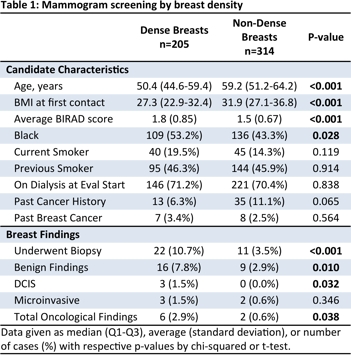Risk Factors Influencing Mammography Screening During Kidney Transplant Evaluation
J. Stoecker, D. Cote, J. Augustine, N. Sarabu, J. Schulak, E. Sanchez, V. Humphreville, J. Ammori, K. Woodside.
Transplant Institute, University Hospitals & Case Western Reserve University, Cleveland, OH.
Meeting: 2015 American Transplant Congress
Abstract number: D41
Keywords: Kidney transplantation, Malignancy, Risk factors, Screening
Session Information
Session Name: Poster Session D: Diabetes/Metabolic/Bone/Malignancy/Pregnancy
Session Type: Poster Session
Date: Tuesday, May 5, 2015
Session Time: 5:30pm-6:30pm
 Presentation Time: 5:30pm-6:30pm
Presentation Time: 5:30pm-6:30pm
Location: Exhibit Hall E
INTRO:
Transplant centers typically require mammography (MMG) for women ≥ 40 as part of the evaluation process. The American Cancer Society recommends annual mammograms for the general population starting at 40 while the USPSTF recommends biennial mammography between age 50-74. Recently, the Swiss Medical Board has sparked further controversy by stating that they no longer recommend mammography-screening programs. We sought to determine characteristics of concern on MMG in the pretransplant renal failure population.
METHODS:
We retrospectively examined women undergoing kidney transplant evaluation at a single institution from 2006 to 2012 who were ≥ 40 (n=567) by 2012. Comparisons were based on demographics at transplant evaluation and MMG findings, with the outcome of interest defined as ductal carcinoma in situ (DCIS) or breast malignancy.
RESULTS:
We found that 19.0% of the screening mammograms during the evaluation period had a positive first impression requiring follow up compared to a reported rate of 9.6% in the general populace. Patients 40-49 and patients 50+ were found to have similar biopsy rates (8.6% vs. 5.6%, p=0.42) and rates of DCIS/malignancy (1.3% vs. 1.5%, p=0.42). Patient BMI, and smoking status did not independently impact the breast biopsy rate or total oncological findings. Black patients had an increased breast biopsy rate (OR=2.24, [1.02-4.89]), but did not have increased rate of DCIS/malignancy (OR=3.50, [0.70-17.51]). Patients with denser breasts (>50% fibroglandular tissue) were more likely to be younger, black, with increased BIRAD scores, and with a lower BMI [Table 1]. Such patients had increased biopsy events (OR=1.85, [1.16-2.95]), and increased risk of DCIS/malignancy (OR=1.64, [1.05-2.57]). 
CONCLUSIONS:
Breast density is a risk factor for breast malignancy in patients with ESRD undergoing transplant. A lower threshold for biopsy may be warranted in patients who have both dense breasts and an indeterminate lesion (BIRADS-3). We recommend annual breast screening starting at age 40.
To cite this abstract in AMA style:
Stoecker J, Cote D, Augustine J, Sarabu N, Schulak J, Sanchez E, Humphreville V, Ammori J, Woodside K. Risk Factors Influencing Mammography Screening During Kidney Transplant Evaluation [abstract]. Am J Transplant. 2015; 15 (suppl 3). https://atcmeetingabstracts.com/abstract/risk-factors-influencing-mammography-screening-during-kidney-transplant-evaluation/. Accessed December 30, 2025.« Back to 2015 American Transplant Congress
